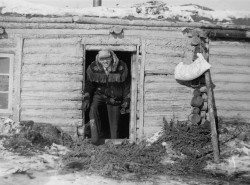It was the mid-1930s, and spiritual darkness reigned in Canada’s North. The work of the Methodists, that during the late 1800’s had brought great blessing, had lost its vigor, fundamental nature and evangelistic fervor. Formalism characterized the worship patterns that remained. Hopelessness once again was paralyzing the hearts of Canada’s Indigenous peoples. Prospects for change appeared bleak.
However, the time was ripe, and God began stirring certain men’s hearts.
A Rustle of Concern
 In 1936, Isaac Reine, who was working at Goldfields, in northern Saskatchewan, became deeply moved by the sight of the bondage of sin of Native people wherever he traveled. Although under appointment as a missionary to Africa, he took time to share his burden with concerned Christians across Canada. He never made it to Africa. While approaching the municipal airport in Hamilton (ON), his small training plane ran into extreme turbulence and dropped to the ground killing him instantly. He was 43 years of age, and unmarried.
In 1936, Isaac Reine, who was working at Goldfields, in northern Saskatchewan, became deeply moved by the sight of the bondage of sin of Native people wherever he traveled. Although under appointment as a missionary to Africa, he took time to share his burden with concerned Christians across Canada. He never made it to Africa. While approaching the municipal airport in Hamilton (ON), his small training plane ran into extreme turbulence and dropped to the ground killing him instantly. He was 43 years of age, and unmarried.
Issac Reine will not be remembered for a long and successful missionary career. But he should be remembered as a man deeply committed to Christ’s Great Commission … a man who, by word and example, did not shirk from challenging Christian believers about their responsibility to reach the lost. Most of all he is remembered as a man who believed in the underlying role of prayer in missions. For it was while he was making the needs of the spiritually lost known, through prayer God was raising up a missionary band that would give many of Canada’s First Peoples an opportunity to hear of His saving grace.
God Deals With a Homesteader
It was shortly after this that a rancher in the Meadow Lake, Saskatchewan area by the name of Stan Collie found Christ. With a heart burning for the lost he endeavored to go to Africa, but was turned down due to his age and the size of his family. Undaunted, he turned northward, and in 1939 caught a ride on a freighting expedition carrying supplies to outposts along the mighty Churchill River. What he saw that summer left an indelible imprint on his soul. He returned home, sold the ranch, loaded his family and belongings into a covered wagon pulled by four horses, and headed north. When the bush trail they traveled on came to an end, they traded the horses for a scow and sailed up Deep River to Buffalo Narrows where they settled.
Serving Alone
The first winter was rugged. With no church behind them or any regular financial support, it was touch and go for that first missionary family. But the flame of God’s love burning in their hearts and a growing awareness of the tremendous needs in the North kept their faith strong, and the first rigorous winter passed into history, a whole story in itself.
A Common Calling
In 1944 Arthur & Martha Tarry, along with their young family, left a pastorate in south-central Saskatchewan to join the Collies in Buffalo Narrows. Having sprung from a rural background, the work rather naturally became associated with the Canadian Sunday School Mission. With expansion, there came a growing realization that this ministry to Aboriginal people could best be performed under a separate organization. Thus the missionaries were led, in mutual agreement with the CSSM, to establish an interdenominational mission board particularly devoted to reaching Canada’s northern Native people.
A Mission Established
In June of 1946 the northern missionaries met in Meadow Lake, Saskatchewan, and founded the Northern Canada Evangelical Mission with nine charter members and three mission stations. The Mission functioned with its headquarters in the isolated village of Buffalo Narrows. An office building was constructed and a printing press was acquired. Soon a language school was initiated for candidates applying for missionary service.
Vision & Growth
The vision of these early missionaries extended far beyond Buffalo Narrows and northwestern Saskatchewan. The Lord blessed their prayers and efforts to expand the work and by NCEM’s 10th Anniversary there were 80 workers on 30 stations.
More about OUR HISTORY …
If you are interested in a more extensive recounting of NCEM’s history, you may want to download “Light on the Horizon” — a book we published in 1996 on the occasion of NCEM’s 50th Anniversary.
Click Light on the Horizon (pdf)

